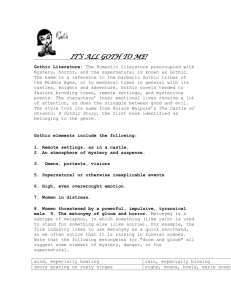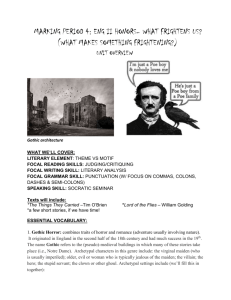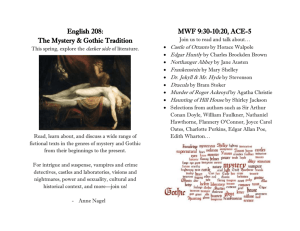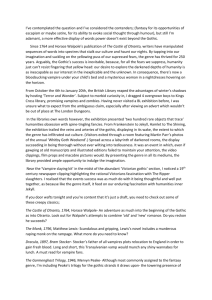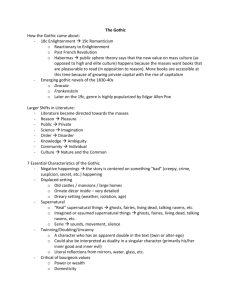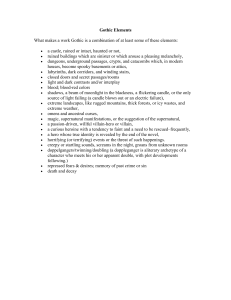A New Kind of Fear
advertisement
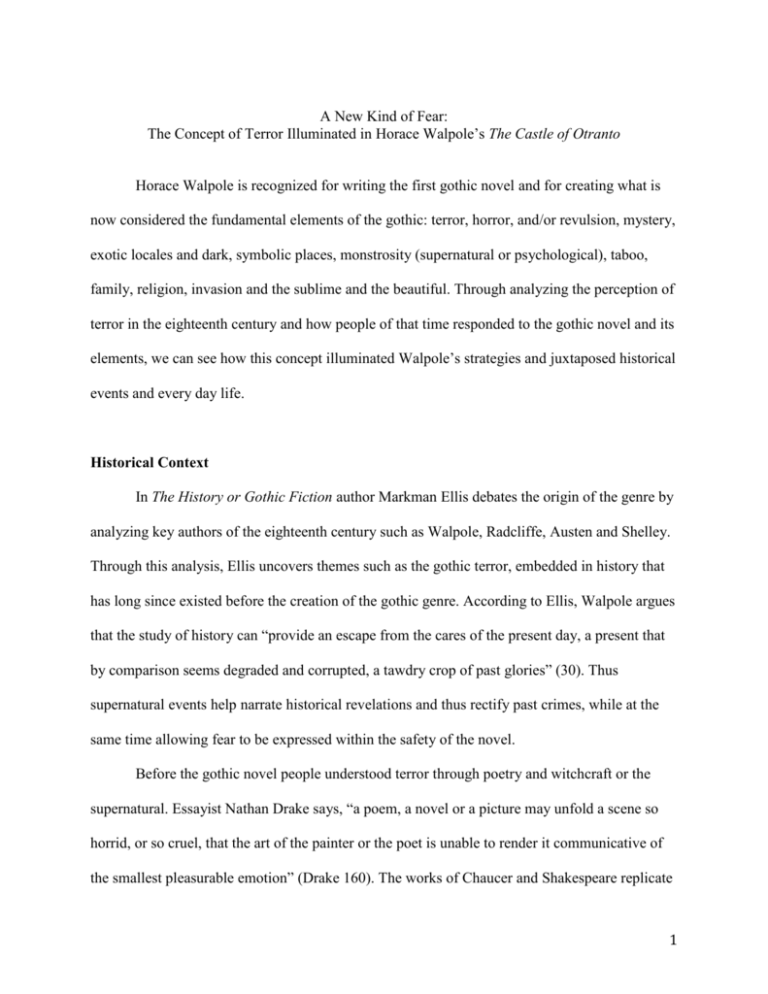
A New Kind of Fear: The Concept of Terror Illuminated in Horace Walpole’s The Castle of Otranto Horace Walpole is recognized for writing the first gothic novel and for creating what is now considered the fundamental elements of the gothic: terror, horror, and/or revulsion, mystery, exotic locales and dark, symbolic places, monstrosity (supernatural or psychological), taboo, family, religion, invasion and the sublime and the beautiful. Through analyzing the perception of terror in the eighteenth century and how people of that time responded to the gothic novel and its elements, we can see how this concept illuminated Walpole’s strategies and juxtaposed historical events and every day life. Historical Context In The History or Gothic Fiction author Markman Ellis debates the origin of the genre by analyzing key authors of the eighteenth century such as Walpole, Radcliffe, Austen and Shelley. Through this analysis, Ellis uncovers themes such as the gothic terror, embedded in history that has long since existed before the creation of the gothic genre. According to Ellis, Walpole argues that the study of history can “provide an escape from the cares of the present day, a present that by comparison seems degraded and corrupted, a tawdry crop of past glories” (30). Thus supernatural events help narrate historical revelations and thus rectify past crimes, while at the same time allowing fear to be expressed within the safety of the novel. Before the gothic novel people understood terror through poetry and witchcraft or the supernatural. Essayist Nathan Drake says, “a poem, a novel or a picture may unfold a scene so horrid, or so cruel, that the art of the painter or the poet is unable to render it communicative of the smallest pleasurable emotion” (Drake 160). The works of Chaucer and Shakespeare replicate 1 this design, and so too does Walpole the moment Manfred draws his dagger, “plunging it over her shoulder and into the bosom of the person that spoke” (Walpole 115). The reader feels a deep sense of sadness and remorse because the woman of whom Manfred believed to be Isabella was in fact his own daughter, Matilda. Despite the reader’s distaste for Manfred, it is impossible to feel the slightest bit of satisfaction that Manfred will most likely be punished for this (or so the reader assumes, if not by society than by his own tormented heart) because the horrors of this scene are too realistic to be pleasurable. Furthermore, witchcraft, a seemingly obsolete practice today existed during the eighteenth century and for two centuries afterwards, because witches were thought to really exist (Drake 159). Although witchcraft is still used today, it is not as prevalent as it was in the 1700s and 1800s. The Castle of Otranto doesn’t necessarily show witchcraft, but it does hold elements of the supernatural. In addition, Matthew Lewis’s novel, The Monk, witchcraft and sorcery are the main forces of evil that drive the plot forward. This idea of the supernatural had a large impact on society, and as the public and literary critics became more interested in pursing this intangible idea, the role of emotion in literature changed (Drake 154). One way we see this change is the movement away from romance (although it is still present it’s not the main focus of the novel) towards the gothic themes of terror, which correspond with every day life (Ellis 33). For example, Manfred represents both a political and domestic tyrant who uses his powers to gain control over property and people. Although Manfred is married to Hippolita, a sweet and caring woman, he pursues Isabella who wants nothing to do with him. Manfred uses his reign to send men out to look for Isabella. In the end, through a series of unfortunate events, it is Manfred’s greed and self-righteousness that leads to his demise. 2 As the gothic gained popularity amongst writers throughout the eighteenth and nineteenth centuries, the terrors become more terrifying. While the helmet is the first sign of the supernatural in Walpole’s novel, neither the helmet nor any other supernatural occurrences illicit fear, but rather “the dominant effect they create is low comedy” (Ellis, 32). Although the supernatural events proliferate: the sighing portraits and later, glimpses of the giant, these events rarely conjure tension or fear. However, Walpole succeeds in creating fear, Ellis says, by varying his strategy of terror by deliberately withholding information from the reader. As a result Walpole creates a “controlled tension,” which dissolves into shock and produces the feeling of horror (32). This shows yet another change in the emotional response in literature, from terror to horror. The arrival of the knights bearing a giant sword from the Holy Land reinforces this idea: Wher’er a casque that suits this sword is found, With perils is thy daughter compass’d round: Alfonso’s blood alone can save the maid, And quiet a long-restless prince’s shade (81). The prophecy from the beginning of the novel is now made clear and the sword is finally connected to the helmet (or casque) that killed Conrad. The narrative of Otranto thus depends on two secret and enigmatic family histories: those of the families of Manfred and Theodore. The characters are helpless without this knowledge, “which are revealed by forces not only outside their control but outside the natural (the supernatural in fact)” (Ellis 33). This is seen especially with the capture, imprisonment and sentence to death of Theodore, and furthermore the end of a political and domestic tyrant. Terror vs. Horror 3 The In The Castle of Otranto it is the property that drives the novel forward; the castle itself acts as the setting where both the main plot and the subplot take place, as well as the supernatural occurrences. However, in order to understand the role of terror in the gothic novel it is important to recognize the differences between terror and horror. Gothic novels not only rely on place to situate the plot but also to evoke the terror of gothic themes. English Professor Robert D. Hume distinguished two subgenres of the gothic novel—the novel of terror and the novel of horror. He traced them through novels of the eighteenth century to present-day novels such as Moby Dick where it is considered the “terror-gothic” (Fleenor 176). While terror and horror can overlap in certain circumstances, they are caused by very different emotions, feelings and happenings. Hume explains that terror comes from the unknown and that is much more of a psychological matter than horror. For example, the uneasiness of [the reader] not fully understanding the significance behind the ancient prophecy, which claimed that “the Castle and Lordship of Otranto should pass from the present family whenever the real owner should be grown too large to inhabit it” (7). This passage sets an ominous tone from the get-go, insinuating there is a curse upon the family and foreshadows what is to come, while still leaving a sense of uncertainty for the reader. Terror, or fear, takes hold of the mind and forces the victim or the reader to think of every possible thing that could go wrong, what could possibly lurking around the corner, or even how terrifying the monster really is. Ann Radcliffe says, “Terror and horror are so far opposite, that the first expands the soul, and awakens the faculties to a high degree of life; the other contracts, freezes, and nearly annihilates them” (Fleenor 186). It might be easy to think of this outside of the literary world and into the world of film. Movie trailers, especially those of horror films, are 4 meant to create a sense of mystery and suspense like in The Purge, which seems particularly terrifying. However, sometimes that does not happen because too much is given away at once, like in Halloween, and the movie doesn’t seem as appealing because it is less terrifying. On the other hand, Ellis says, “terror, the author’s principle engine, prevents the story from ever languishing; and it is so often contrasted by pity, that the mind is kept up in a constant vicissitude of interesting passions” (30). This is exactly what Walpole does in the main plot when Isabella first escapes from the castle, and then being found and almost forced to marry Manfred. The sub-plot mirrors that terrifying unease with the romance between Matilda and Theodore, which ends in Matilda’s death and the union on Theodore and Isabella. While terror is purely mental, horror is physical. It is physical in the sense of witnessing a monster (or the giant or ghost in the case of The Castle of Otranto) or some gruesome circumstance, whatever that may be. Horror is introduced the moment the helmet crashes, but from where nobody knows, and kills Conrad in the beginning of the novel. “His child dashed to pieces, and almost buried under an enormous helmet, a hundred times more large than any casque ever made for human being, and shaded with a proportional quantity of black feathers” (Walpole 9). Although a contemporary reader might find this more ironic or comedic, rather than terrifying, this scene sets up the novel in the first few pages and forces the reader to gain a sense of horror. According to author and literary critic, David Stevens, “Gothic and horror seem to belong together, so close in their relationship. Horror, however, does not have to be present in a gothic text; neither does its presence necessarily make a gothic text” (6). Although horror does not have to exist, its presence makes the story more exhilarating. And being the first gothic novel the response of most readers found Walpole’s novel to be the least bit terrifying. This low reception 5 from the public might attribute to the fact that it was the first of its kind and therefore an experiment of a new literary form. The gothic elements that exist in The Castle of Otranto, whether terrifying or funny, have set the bar and have enabled the gothic to overlap terror and horror and create a heightened emotional response. The Sublime “The sublime is the strongest emotion humans and animals can experience,” says Politician and Philosopher Edmund Burke, and it is because it completely fills our minds so that there is no other emotion possible (194). Burke believes that the relationship between the beautiful and the sublime are mutually exclusive, in which either one can produce pleasure. However, Burke’s says, “whatever is fitted to any sort to excite the ideas of pain and danger, that is to say, whatever is in any sort terrible, or is conversant about terrible objects, or operates in a manner analogous to terror, is a source of the sublime” (191). An example of this from the novel would be the odd noises heard around the castle, the giant seen roaming the halls, and of course the castle itself in its grandiose manner: An awful silence reigned throughout those subterraneous regions, except now and then some blasts of wind that shook the doors she had passed, and which, grating on the rusty hinges, were re-echoed through that long labyrinth of darkness. Every murmur struck her with new terror (19). The descriptions are what make the elements of the sublime in the gothic seem so relatable to the reader. However, it is not only the elements of setting and plot that make up the sublime; it is the characters, specifically the villains, whom elicit that highest level of fear. “Isabella, whom every incident was sufficient to dismay, hesitated whether she should proceed. Her dread of Manfred soon outweighed every other terror” (20). This is exactly what Burke means when he says, 6 “whatever is qualified to cause terror is a foundation capable of the sublime” (194). It is in this sense that we can say that the sublime creates the most powerful emotion; it occupies us completely and leaves us trembling and shocked. Certain elements manifest themselves in the gothic to the extent of which it takes over not only the emotional response of the reader, but of the genre itself. Paralyzed with the fear of the unknown, Walpole successfully conceptualizes terror in a new way, one that can be used to cope with every day struggles or fantastical visions of the mind. While it is up to the writer to create this platform, the reader must use their imagination, and only when those two parallels cross does the gothic truly shed light on the sublime. Work Cited 7 Burke, Edmund. A Philosophical Enquiry into the Origin of our Ideas of the Sublime and Beautiful. Vol. 24. New York: P.F. Collier & Son Company, 1909-14. Print. Drake, Nathan. Gothic Documents: a sourcebook 1700-1800. Ed. E.J. Clergy and Robert Miles. Manchester: Manchester University Press, 2000, print. Ellis, Markman. The History of Gothic Fiction. Edinburgh: Edinburgh UP, 2000. Print. Fleenor, Juliann E., ed. The Female Gothic. Montréal: Eden, 1983. Print. Steven, David. The Gothic Tradition. Cambridge: Cambridge University Press, 2000. Print. Walpole, Horace. The Castle of Otranto. Oxford: Oxford UP, 2008. Print. 8

